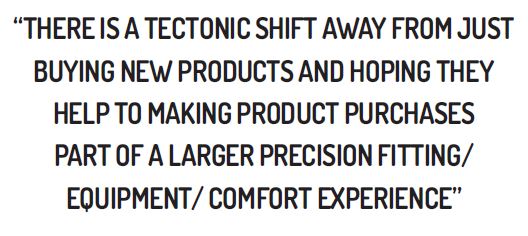Vosper: Four things bike shop owners can do right now to increase 2019 revenues
The cycling industry is in a period of rapid – and perhaps accelerating – change. This editorial is first in a year-long series commissioned by Cycling Industry News to explore what those changes are, how they might impact the bike business, and what we as an industry can do about them. By Rick Vosper, bike industry annoyance since 1993.
It is in the nature of change to create uncertainty. But it is equally in the nature of change to create opportunity. Let’s examine the first two of four of these opportunities specific to retail business owners, which can be implemented relatively easily and quickly enough to positively affect your turnover in 2019.
1 > EXPAND THE SERVICE DEPARTMENT
Retailers in the UK, North America and Australia say they are expanding service offerings in response to what they see as a long-term uptick in demand for parts installation, repairs, and ongoing checkups. This expansion can take the form of allocating more physical service space on the retail floor, adding more material and trained employees to improve turnaround and handle increased services volumes, and/or expanding and marketing your range of service options.
The reason for this is simple: retailers in all markets note more customers coming in with bikes for service. But the reason behind the reason may be less obvious.
In the USA, National Sporting Goods Association (NSGA) data show the frequent adult cycling population in 2017 was up about 7% versus the average since 2000. (More about those numbers another time.) At the same time the number of independent bicycle dealer storefronts declined by more than third between 2001-2014, according to the National Bicycle Dealer Association (NBDA). More riders serviced by fewer retailers equals a net increase of 84% in service customers (and therefore service business) per retailer over the last thirteen years.

That’s a lot of new service business, and a very welcome revenue stream as once-profitable equipment purchases shift increasingly to discount internet sources.
I did a quick survey about planned changes for 2019 in a Facebook group I administer* and the group’s retailers (mostly US) responded, by not quite two to one, that expanding service was the single most important item mentioned.
In other markets, this growth is not as clear since there is no comparable data available. However, CIN managing editor Jon Harker reports the service expansion trend seems to be picking up in the UK to a lesser, but still significant, degree. Australia is even less clear, and I’d appreciate input from more Aussie retailers about this trend.
2 > BIKE FIT
Active cyclists in all markets are increasingly accepting the concept if you want to be comfortable on your bike, the most important step is be properly fitted by a professional. There is a tectonic shift away from just buying new products and hoping they help to making product purchases part of a larger precision fitting/equipment/comfort experience. Retailers who want to cash in on this experience can do so by getting closer to local professional bike fitters in one or more of three ways.
The first and easiest method is simply to cultivate relationships with fitters in your area. The proposition: you send fittings to them, they refer the resulting bike or equipment business back to you.
The second is to sell fitting as part of an integrated new bike purchase package. Once the customer has decided on a preferred type, make or model (and, hopefully made a deposit to secure the purchase), they go to the fitter for a final determination. The customer’s purchase price may include equipment and even frame-size swap outs, and the fitter gets their (discounted) fee from the purchase package.

Everyone wins: the customer gets a bike that fits perfectly from the outset, you make an increased profit from the bike, equipment side and the fitting sides, and the fitter makes a profit on business they might not
have gotten otherwise. One caveat would be to figure the swap-out service carefully on several fronts, including the cost of an average exchange, value of equipment swapped out/taken in and the opportunity to capture revenue instead of having it go to an online discounter with the customer stuck with the leftover bits and probably resenting you for it.
Finally and space permitting, you can bring fitting in-house either on an as-needed basis or for a few scheduled days each week. Here the arrangement is a little more complex. You’re leasing space to the fitter, probably as a percentage of the work, but you have far more control of the process and sales that come from it, not to mention the prestige of an added layer of service and professionalism for your business.
Join me in my next article for CIN issue as we unpack some of the mechanics around in-store bicycle hire (rentals, to us Americans) and sale of used bikes, either on the shop floor or out the back door via the internet.
*The members-only group mentioned earlier is Cycling industry Recovery, which discusses topics of interest to the industry. We currently have more than three hundred participants and welcome industry members and alumni from all markets and market sectors.
Read more from Rick Vosper on CIN.
Image by Elissa Capelle Vaughn from Pixabay



